
Introduction
Imagine walking into a room where the vibrant, almost velvety red leaves of the Philodendron Imperial Red catch your eye, turning a simple corner into an exotic retreat. This isn’t just any plant; it has a unique charm, drawing plant lovers into its orbit with its luxurious color palette, ranging from deep burgundy to shiny dark green. Hi, I’m Anitha, an avid botanist and houseplant enthusiast for over a decade. My love for Philodendrons, especially the Imperial Red, has grown from a hobby into a full-blown passion, guiding me through the nurturing of these stunning plants and exploring their captivating world.
Caring for a Philodendron Imperial Red, while deeply rewarding, comes with its set of challenges. Their royal hues demand just the right light, their soil a perfect balance of moisture and drainage, making them sometimes appear as regal and demanding as their name suggests. But fear not, for this guide is designed to empower you. Whether you’re a seasoned gardener or a novice green thumb, I’ll share with you invaluable insights and practical tips to transform these challenges into a simple, enjoyable part of your gardening routine. Together, we’ll ensure your Philodendron Imperial Red not only survives but thrives, turning your space into a lush, tropical haven.
Unveiling the Philodendron Imperial Red
Botanical Background
The Philodendron Imperial Red, a jewel in the crown of tropical houseplants, boasts an intriguing lineage that traces back to the rainforests of South America. Belonging to the Araceae family, this philodendron is a man-made hybrid, designed to captivate with its stunning foliage and robust growth. Unlike its wild relatives that climb trees and spread across forest floors, the Imperial Red stands proud with its upright, self-supporting growth habit, making it a perfect indoor companion.
This fascinating plant is not just about aesthetics; it’s a study in adaptability and resilience, showcasing unique features that contribute to its survival. Each glossy leaf, with its rich color spectrum, is a masterclass in nature’s artistry, optimized for photosynthesis even in the dim, dappled light of rainforest canopies. The variation in leaf color from deep burgundy to dark green isn’t just for show; it reflects the plant’s stage of growth and environmental adjustments, being a dynamic indicator of its well-being.
Unveiling the Red: Factors Affecting Color Vibrancy
The vibrancy of the Philodendron Imperial Red’s leaves is a spectacle to behold, but achieving and maintaining that lush, vivid color requires understanding the trio of light, temperature, and nutrients—each a crucial factor in the tapestry of coloration.
Light: Just as an artist needs the right lighting to bring their artwork to life, the Imperial Red needs the perfect balance of light to showcase its magnificent hues. Bright, indirect light is the sweet spot, mimicking the dappled sunlight of its natural habitat. Too little light, and the leaves will lean towards green; too much, and you risk fading the colors and damaging the plant.
Temperature: Temperature plays a subtle yet significant role in the health and color vibrancy of this tropical beauty. Comfortable room temperatures between 65°F (18°C) to 80°F (27°C) encourage rich, vivid colors. Exposure to temperatures outside this range can lead to a dulling of the leaves’ vibrant palette, as the plant struggles to maintain its core functions.
Nutrients: Like feeding the flames of a fire, the right nutrients can intensify the reds and burgundies of the Imperial Red’s foliage. A balanced, slow-release fertilizer, rich in macronutrients, supports not just the growth, but the richness of the leaves’ color. Over-fertilizing, however, can have the opposite effect, leading to leaf burn and color dilution, so moderation is key.
In essence, the secret to the Imperial Red’s arresting beauty lies in understanding and mimicking its native environment as closely as possible. By doing so, you invite not just the elegance, but the very spirit of the tropics into your home.
Mastering Philodendron Imperial Red Care

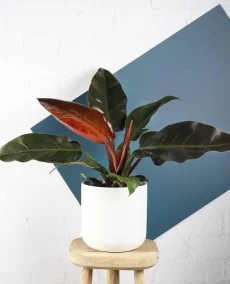
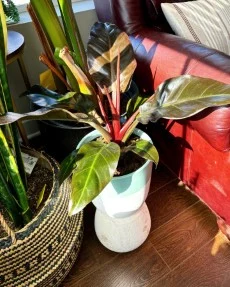
Light Requirements:
The Philodendron Imperial Red flourishes under bright, indirect light. It’s akin to replicating the filtered sunlight of its native rainforest, where tall trees provide a protective, dappled canopy. If the leaves begin to fade in color or the stems stretch out, it’s a sign of insufficient light. Conversely, leaves that turn yellow or show signs of scorching are crying out from too much direct sunlight. Positioning your Philodendron near an east-facing window, where it can bask in the gentle morning light, or a few feet away from a south or west-facing window, shielded by sheer curtains, is ideal.
Watering Wisdom: When & How Much:
Understanding when to water your Philodendron Imperial Red is crucial. The finger test—inserting your finger up to the first knuckle into the soil—will tell you all you need to know. If the soil feels dry, it’s time to water; if it’s moist, wait a bit longer. During the warmer months, your Philodendron will drink more, necessitating watering once a week or more, depending on the size of the pot and the room’s temperature. In cooler months, water less frequently, allowing the soil to dry out slightly between waterings.
Drainage:
The significance of well-draining soil and pots with drainage holes cannot be overstated. These prevent water from pooling at the bottom of the pot, thwarting root rot—a deadly nemesis. Ensuring that excess water can escape freely means you’re providing an environment akin to the well-aerated, fast-draining floor of its rainforest home.
Soil Secrets: Ideal Mix:
A well-draining, aerated potting mix is paramount. Incorporate perlite or orchid bark to boost drainage and aeration, creating conditions that allow roots to breathe and flourish. This mix also helps in regulating moisture levels, ensuring that your Philodendron Imperial Red has a happy and healthy growing medium.
Fertilizing:
Feed your Philodendron Imperial Red with a balanced, slow-release fertilizer during the growing season (spring through summer). Diluting the fertilizer to half the recommended strength can prevent overfeeding, safeguarding the plant from potential nutrient burn. Fertilize once a month to invigorate growth and color vibrancy.
Temperature & Humidity: Optimal Range:
Philodendron Imperial Red enjoys a temperature range of 65°F (18°C) to 80°F (27°C) and high humidity levels akin to its tropical origins. Maintaining this comfortable environment can be achieved with regular misting, although you should be cautious to avoid wetting the leaves excessively.
Humidity Hacks:
Creating a microclimate with higher humidity can be simple. Utilize pebble trays filled with water under your plant’s pot, invest in a humidifier, or group your plants together. These methods can significantly increase the ambient moisture, simulating the humid atmosphere of a tropical rainforest, and providing your Philodendron Imperial Red with conditions it will love.
By understanding and applying these care principles, you’ll be well on your way to nurturing a vibrant and lush Philodendron Imperial Red, bringing a touch of tropical elegance to your indoor garden.
Pro Tips for a Thriving Philodendron Imperial Red

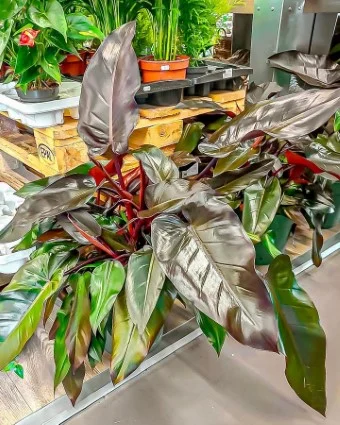
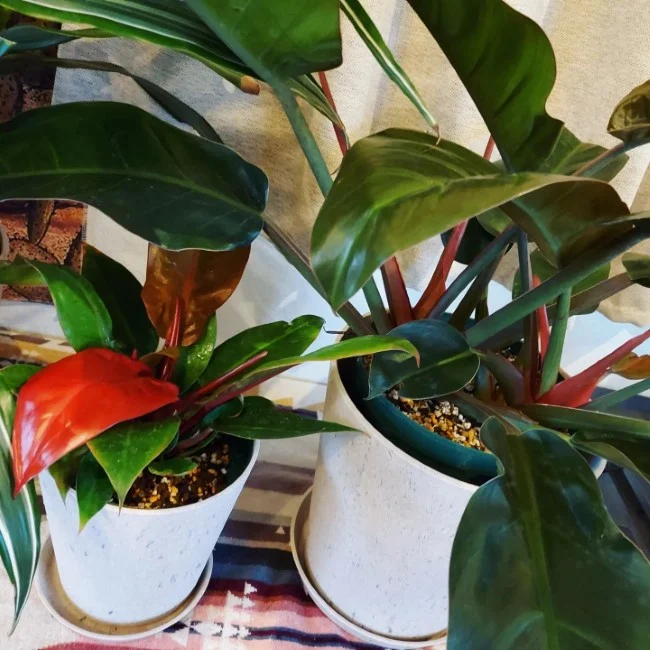
Potting & Repotting: Size Matters & Gentle Guidance
When it comes to potting and repotting your Philodendron Imperial Red, size does indeed matter. A pot that’s too large can lead to waterlogging issues, while too small a pot may stunt the plant’s growth and lead to it becoming rootbound. For young plants or those recently propagated, start with a pot that’s 2-3 inches larger in diameter than the root ball. Mature plants, on the other hand, flourish in a pot that’s snug yet spacious enough to accommodate one to two years of growth before needing a size up.
Repotting Steps for Minimal Root Stress:
- Prepare: Choose a new pot that’s 2-3 inches larger than the current one. Ensure it has drainage holes.
- Mix: Create a well-draining soil mix, blending perlite or orchid bark to promote aeration.
- Water: Lightly water your plant 24 hours before repotting to reduce root stress.
- Remove: Gently take the plant out of its current pot, cradling the base to support it fully.
- Inspect: Examine the roots, trimming any that are dead or overly long, but be gentle to preserve the root structure.
- Pot: Place the plant in its new pot, filling around it with your soil mix, allowing the plant to sit at the same depth it was previously.
- Water: Water lightly to settle the plant into its new home and reduce transplant shock.
Common Issues & Solutions: Roots, Rot, and Pests Be Gone
Brown Leaves: Often a sign of overwatering or low humidity. Ensure your watering schedule reflects the plant’s needs, and increase humidity around the plant.
Stunted Growth: This can indicate insufficient light or the need for repotting. Move your plant to a brighter location and consider if it’s time for a larger home.
Pests: Aphids, mealybugs, and spider mites might visit. For organic control, neem oil is an effective, natural insecticide. Apply it to the leaves according to product instructions, making sure to cover both sides.
Propagation Techniques: Clone Your Imperial Red
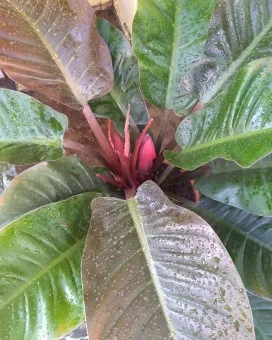
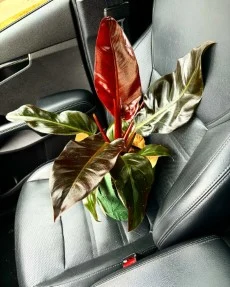
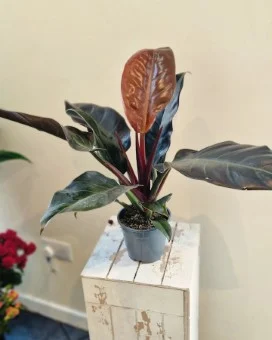
Stem Cutting Propagation With Pictures
- Select: Choose a healthy stem with at least two nodes (the small bumps where leaves and roots emerge).
- Cut: Using a sterilized blade, cut just below a node.
- Root: Place the cutting in water or moist soil, ensuring at least one node is submerged.
- Wait: Change the water weekly or keep the soil moist. Roots should appear in 2-4 weeks.
- Pot: Once roots are a few inches long, pot the cutting in its permanent home.
Alternative Method: Air Layering
For experienced plant parents, air layering offers a way to propagate while the stem is still attached to the parent plant, encouraging roots to develop on a segment of the stem before cutting it off. This method is particularly useful for larger or more mature specimens where stem cuttings might not be viable.
By following these in-depth care and propagation guidelines, your Philodendron Imperial Red will not only survive but thrive, embodying the lush, tropical essence of its native environment right in your living room.
Conclusion
Recap & Key Takeaways
In conclusion, caring for your Philodendron Imperial Red encompasses a few critical elements that ensure its vibrant health and growth. Remember, a well-draining, aerated potting mix enriched with perlite or orchid bark is crucial for root health. Regular feeding with a balanced, slow-release fertilizer during the growing season will keep your plant lush and vibrant. Temperature and humidity levels should mimic its native tropical environment, achievable through misting and using pebble trays or a humidifier. When it’s time to pot or repot, choose the right size to avoid waterlogging issues and ensure a snug fit for healthy growth. Stay vigilant for signs of brown leaves, stunted growth, or pests, adjusting care routines as necessary. Lastly, don’t forget to experiment with propagation through stem cutting or air layering to expand your Philodendron family.
Call to Action
We’d love to hear about your Philodendron Imperial Red journey! Share your successes, challenges, and any questions you might have in the comments below. Your insights and experiences can help create a vibrant community of plant lovers, learning and growing together.
Author Bio
As an avid plant enthusiast with years of experience nurturing an array of tropical plants, my passion for Philodendrons has grown into a significant part of my life. Through trial, error, and continuous learning, I’ve gathered a wealth of knowledge on how to care for these magnificent plants. My aim is to share this passion and expertise with fellow plant lovers, offering guidance and support to help your indoor gardens flourish.
